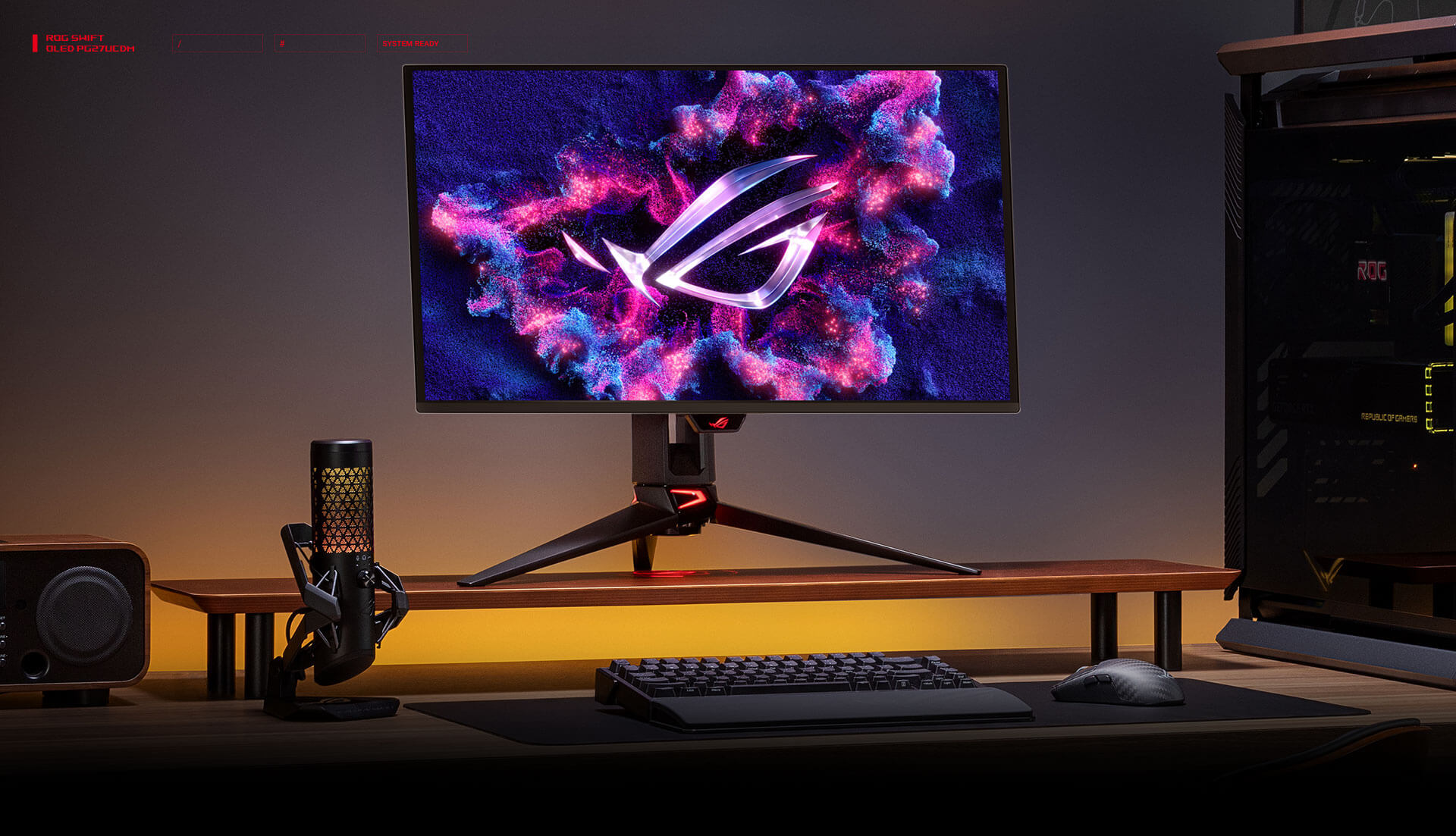The ASUS ROG Swift OLED PG27UCDM is not just another high-refresh-rate gaming monitor—it’s a statement. As one of the first 27-inch displays to combine 4K resolution with a blistering 240Hz refresh rate on a 4th-gen QD-OLED panel, it enters the market with serious ambitions. Competing with heavyweights like the Alienware AW2725Q and Samsung Odyssey G81SF, this monitor positions itself at the peak of what’s possible in premium PC gaming setups.
Next-Gen Display Tech with 240Hz Fluidity
At its core, the PG27UCDM boasts a 26.5-inch QD-OLED panel delivering 3840×2160 resolution, 0.03ms GTG response time, and an industry-leading 240Hz refresh rate. Unlike many monitors that require compression at high refresh rates, this display’s DisplayPort 2.1a UHBR20 (80Gbps) lets you run uncompressed 4K240Hz, ensuring ultra-smooth visuals for systems with capable GPUs.
The monitor excels in motion clarity, boasting sub-0.5ms response times across refresh rates. Whether you’re engaged in esports or cinematic AAA titles, motion remains blur-free and lifelike. G-SYNC compatibility, AMD FreeSync, and HDMI Forum VRR are all on board, making it a versatile pick for both PC and console gamers.
However, one minor caveat is noticeable VRR flicker in dark scenes—a known issue in many OLEDs—which the OLED Anti-Flicker 2.0 attempts to reduce, albeit with limited success.
Visual Brilliance, True HDR, and Pro-Grade Color Accuracy
The PG27UCDM delivers near-infinite contrast, thanks to its OLED panel, providing deep blacks and bright highlights that make HDR content truly pop. It’s certified for VESA DisplayHDR 400 True Black and supports Dolby Vision, with peak HDR brightness exceeding 1000 nits in small highlights.
Color coverage is nothing short of professional:
- 99% DCI-P3
- 100% sRGB
- 10-bit true color
- Delta E < 2 post-calibration
For creators, the monitor’s DisplayWidget Center provides access to color settings and calibration tools, while its USB-C with 90W PD, KVM switch, and tripod socket add real-world utility for multitaskers and streamers.
One standout feature for productivity and content creators is its pixel density of 166 PPI, giving it noticeably sharper text and detail than larger QD-OLEDs like the PG32UCDM. It also handles gradient transitions with minimal banding and offers excellent SDR and HDR color volume performance.
Build, Ergonomics, and OLED Burn-In Protection
ASUS has engineered the PG27UCDM with a premium feel. The metal panel casing, minimal wobble stand, and excellent ergonomics (tilt, swivel, pivot, and height adjustment) ensure both form and function. It’s also wall-mount compatible (VESA 100×100) and includes solid cable management.
Crucially, ASUS added OLED Care Pro, which uses a Neo Proximity Sensor to detect when you’re away and trigger screen-saving measures, reducing the risk of burn-in. Combined with Uniform Brightness and Anti-Flicker 2.0, the monitor prioritizes panel longevity and eye comfort for long gaming sessions.
Verdict: The Best 27-Inch OLED Gaming Monitor?
The ASUS ROG Swift OLED PG27UCDM is arguably the most advanced 27-inch gaming monitor on the market in 2025. While its price may be on the premium side, it offers unmatched sharpness, elite motion clarity, and robust HDR performance that few competitors can match.
Pros:
- 240Hz 4K with no compression via DisplayPort 2.1a
- Top-tier OLED HDR with Dolby Vision
- Sharp, vibrant visuals with professional-grade color accuracy
- Excellent build quality and ergonomics
- Burn-in mitigation via Neo Proximity Sensor
Cons:
- VRR flicker remains an issue in dark content
- Ambient light desaturates blacks, typical for QD-OLEDs
- Price premium over similar models like the Dell AW2725Q
For gamers who demand the absolute best in clarity, color, and refresh rate — and for creators who dabble in HDR workflows — the PG27UCDM is a future-proof investment. If you can afford the price tag and have the GPU to push 4K at high refresh rates, there’s little reason to look elsewhere.




